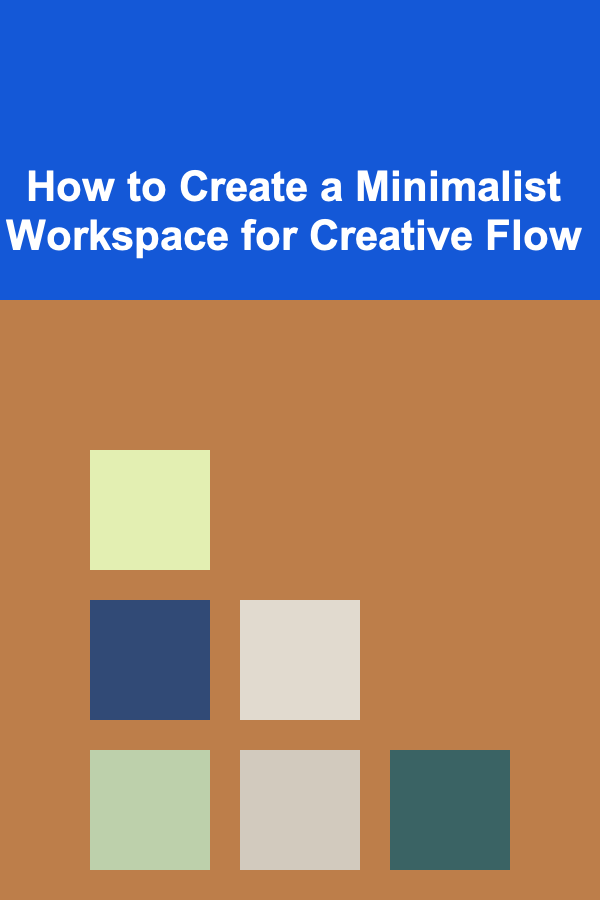
10 Tips for Effective Graphic Design Planner Organization
ebook include PDF & Audio bundle (Micro Guide)
$12.99$6.99
Limited Time Offer! Order within the next:

Graphic design is a multifaceted and often intricate profession that requires not only creativity but also a high level of organization. As a graphic designer, staying organized is key to managing multiple projects, meeting deadlines, and ensuring that your creative process flows smoothly. An effective planner can help you keep track of tasks, ideas, and deadlines while also maintaining your mental clarity and focus.
In this article, we'll discuss ten practical tips for organizing your graphic design planner to maximize productivity, creativity, and efficiency. Whether you're a seasoned professional or just starting, these tips will guide you in managing your workflow, balancing multiple projects, and ultimately becoming a more organized designer.
Define Clear Project Milestones
Before diving into any graphic design project, it's crucial to break down the process into clear, manageable steps. This will prevent the overwhelming feeling of tackling everything at once and help you stay focused.
Why This Matters
A project without clear milestones can feel like an endless task. By setting clear milestones, you're able to track your progress and celebrate small wins, making the entire process more rewarding.
How to Implement:
- Start with the Brief: Begin by identifying the project's key objectives, including the style, audience, and deliverables.
- Break it Down: Divide the project into phases like research, concept design, feedback, revisions, and final output.
- Set Deadlines: Assign realistic deadlines for each phase to keep things on track.
Having a visual timeline or task list in your planner helps keep your work organized and ensures no step is skipped.
Color Code Your Planner
Color coding is a simple yet powerful organizational strategy that allows you to categorize and prioritize tasks effectively. By using different colors for various types of tasks or projects, you'll quickly identify what's urgent, what's creative, and what's routine.
Why This Matters
A cluttered planner can easily become overwhelming. Color coding helps to simplify your visual layout, enabling you to quickly distinguish between different priorities.
How to Implement:
- Assign colors to tasks like design, client communication, feedback, and administrative work.
- Use one color for urgent deadlines and another for long-term projects.
- Consider color-coding based on project types, like branding, web design, or print design.
This method will make it easier to see at a glance which tasks need your immediate attention and which can wait.
Use Templates for Recurring Tasks
As a graphic designer, you'll often encounter repetitive tasks. Whether it's client meetings, invoicing, or regular check-ins, creating templates in your planner can save you time and ensure consistency.
Why This Matters
Using templates allows you to streamline repetitive work, which can free up more time for creative tasks and reduce the mental load of figuring out what to do next.
How to Implement:
- Create Checklists: For tasks like sending initial concepts or requesting client feedback, create checklists that you can easily reuse.
- Incorporate Time Blocks: Set aside specific time slots in your planner for recurring tasks, like social media management, meetings, or creative brainstorming.
Having a template will help ensure that no essential task is overlooked while keeping your schedule organized.
Track Your Time
Time management is a crucial aspect of being a successful graphic designer, especially when juggling multiple projects. Tracking how long each task takes can help you identify inefficiencies and improve your workflow.
Why This Matters
By tracking the time you spend on different tasks, you can better estimate how much time future projects will require and avoid underestimating or overcommitting.
How to Implement:
- Use a time tracker app or a physical tracker in your planner to record the start and end times for each task.
- Set a goal to complete tasks within a certain time frame and try to stick to it.
- Review your time logs periodically to assess where you can improve or where you may need additional resources.
This will help you manage your workload more effectively, ensuring you can meet deadlines without burning out.
Prioritize Your Tasks Using the Eisenhower Matrix
The Eisenhower Matrix is a time-management tool that helps you decide on the priority of tasks by categorizing them into four quadrants based on urgency and importance.
Why This Matters
Without a prioritization system, it's easy to get bogged down in less important tasks while neglecting critical ones. The Eisenhower Matrix helps you focus on what truly matters.
How to Implement:
- Quadrant 1 (Urgent & Important): Tasks that require immediate attention, like finalizing designs for an approaching deadline.
- Quadrant 2 (Not Urgent, But Important): Tasks like brainstorming, research, and personal projects that can be done at a steady pace.
- Quadrant 3 (Urgent, But Not Important): Things like responding to emails or phone calls that can be delegated if possible.
- Quadrant 4 (Not Urgent & Not Important): Tasks that don't contribute much to your goals, such as unimportant social media browsing.
Using this matrix within your planner helps you stay focused on high-priority tasks that truly move your projects forward.
Establish a Client Communication Log
Keeping a log of all client communications is crucial for keeping track of feedback, requests, and deadlines. Without this, miscommunication can easily happen, resulting in confusion and delays.
Why This Matters
Having a dedicated section in your planner for client communication ensures that you have a record of all correspondence and can refer to it when needed.
How to Implement:
- Dedicate a section in your planner to document client meetings, emails, and calls.
- Include key points from each communication, such as feedback on designs, any changes requested, and deadlines.
- Update the log whenever there's new communication, and ensure all updates are reflected in your design plans.
This practice reduces confusion and ensures that you're always up-to-date with client expectations.
Create a Visual Mood Board
A mood board is a powerful visual tool that can help you organize your creative ideas and communicate your vision for a project. Creating one in your planner gives you a tangible reference for inspiration and direction.
Why This Matters
A mood board allows you to capture the essence of a design project in one place, helping you stay aligned with the client's vision and your creative direction.
How to Implement:
- Cut out inspirational images from magazines or print out online images and attach them to your planner.
- Include color swatches, typography samples, and texture ideas.
- Use the mood board as a reference point when sketching or designing, ensuring the concept stays consistent.
A visual reference can be incredibly helpful when refining your designs or during client presentations.
Establish a Digital and Physical Planner Integration
Many graphic designers work with both digital tools and physical planners. A hybrid approach allows you to enjoy the benefits of both systems---digital for convenience and flexibility, and physical for tactile planning and visualization.
Why This Matters
Using both digital and physical planners allows you to stay flexible while maintaining the structure and creativity you need to succeed.
How to Implement:
- Use a digital calendar or task manager for quick access and reminders.
- Have a physical planner or notebook where you can sketch, brainstorm, and make notes.
- Sync your digital calendar with your physical planner by transferring deadlines, milestones, and tasks regularly.
This integration helps ensure you never miss a deadline while still retaining the creative freedom that physical planning offers.
Review and Reflect Regularly
An essential part of staying organized is taking time to review your progress and reflect on your work. Regularly assessing your workflow, tasks, and completed projects allows you to spot areas for improvement.
Why This Matters
Continuous improvement is key to long-term success as a graphic designer. Reflecting on your planning habits helps you identify what works and what needs adjustment.
How to Implement:
- Set aside time each week or month to review your planner and reflect on what you accomplished.
- Take note of any recurring bottlenecks or issues and develop strategies to address them.
- Adjust your planning process as needed to enhance efficiency and creativity.
This habit helps you stay on top of your work and ensures that you're always evolving as a designer.
Include Personal and Creative Time
As a graphic designer, it's easy to become consumed by client work and deadlines. However, personal and creative time is essential for fostering innovation and preventing burnout.
Why This Matters
Taking breaks to recharge, explore new design ideas, or focus on personal projects can reignite your creativity and lead to fresh perspectives in your professional work.
How to Implement:
- Block out time in your planner for personal design projects, experiments, or creative exploration.
- Use this time to try new techniques, learn new software, or attend design workshops.
- Prioritize self-care by scheduling time for activities that help you relax and recharge, such as exercise or meditation.
This ensures that you don't lose sight of the passion that drove you to become a designer in the first place.
Conclusion
Effective graphic design planner organization is more than just about staying on top of deadlines---it's about cultivating a creative workflow that allows you to thrive as a designer. By following these ten tips, you can create a structured yet flexible planning system that supports your creativity, productivity, and well-being. Whether you're organizing your client communication, tracking time, or prioritizing your projects, these strategies will help you become a more organized and effective graphic designer.
Reading More From Our Other Websites
- [Organization Tip 101] How to Create a Cozy and Organized Nursery
- [Survival Kit 101] How to Assemble an Emergency Survival Kit for Small Business Owners and Their Employees
- [Personal Financial Planning 101] How to Avoid Common Retirement Planning Mistakes
- [Organization Tip 101] What Steps Can You Take to Organize Your Outdoor Space?
- [Whitewater Rafting Tip 101] Getting Started on the River: Essential Gear and Prep for New Rafters
- [Home Space Saving 101] How to Use Hidden Storage to Keep Your Home Organized
- [Organization Tip 101] How to Tackle Paper Clutter in Your Home
- [Home Holiday Decoration 101] How to Add Festive Sparkle to Your Home Without Going Overboard
- [Toy Making Tip 101] Retro Revival: Turning Vintage Toys into Modern Masterpieces
- [Home Cleaning 101] How to Clean Your Home Naturally Using Non-Toxic Products

How to Create a Minimalist Workspace for Creative Flow
Read More
How to Foster Respect and Cooperation in Shared Spaces
Read More
How to Use Outdoor Lighting to Deter Criminals
Read More
The Art of Building Successful Client Relationships as an Account Executive
Read More
How to Wear Wide-Leg Pants for Every Occasion
Read More
How to Understand the Science Behind Global Warming
Read MoreOther Products

How to Create a Minimalist Workspace for Creative Flow
Read More
How to Foster Respect and Cooperation in Shared Spaces
Read More
How to Use Outdoor Lighting to Deter Criminals
Read More
The Art of Building Successful Client Relationships as an Account Executive
Read More
How to Wear Wide-Leg Pants for Every Occasion
Read More